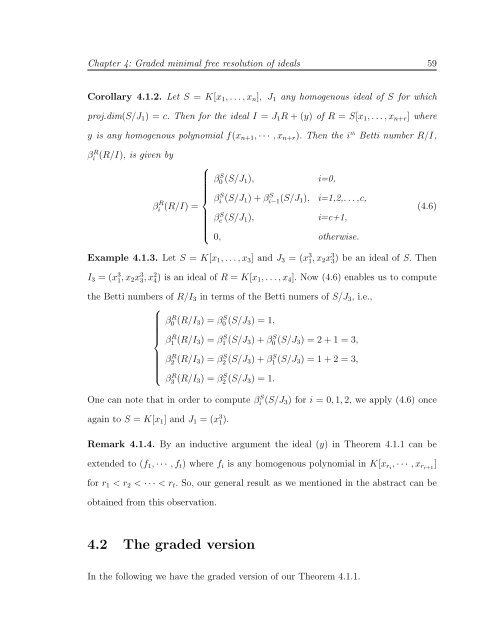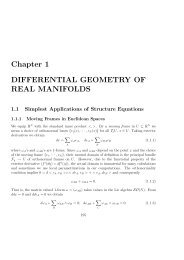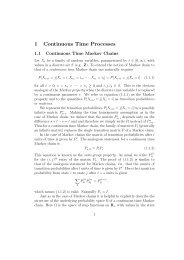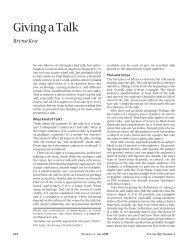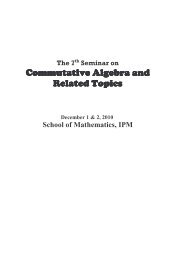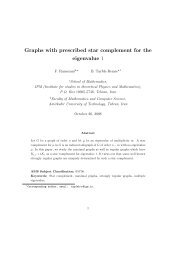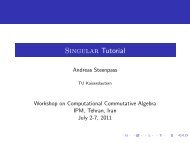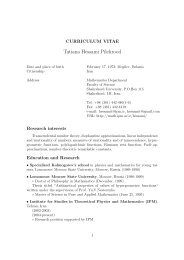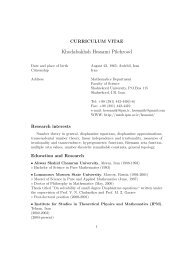Betti numbers of modules over Noetherian rings with ... - IPM
Betti numbers of modules over Noetherian rings with ... - IPM
Betti numbers of modules over Noetherian rings with ... - IPM
You also want an ePaper? Increase the reach of your titles
YUMPU automatically turns print PDFs into web optimized ePapers that Google loves.
Chapter 4: Graded minimal free resolution <strong>of</strong> ideals 59<br />
Corollary 4.1.2. Let S = K[x1, . . . , xn], J1 any homogenous ideal <strong>of</strong> S for which<br />
proj.dim(S/J1) = c. Then for the ideal I = J1R + (y) <strong>of</strong> R = S[x1, . . . , xn+r] where<br />
y is any homogenous polynomial f(xn+1, · · · , xn+r). Then the i th <strong>Betti</strong> number R/I,<br />
β R i (R/I), is given by<br />
β R i (R/I) =<br />
⎧<br />
⎪⎨<br />
⎪⎩<br />
β S 0 (S/J1), i=0,<br />
β S i (S/J1) + β S i−1(S/J1), i=1,2,. . . ,c,<br />
β S c (S/J1), i=c+1,<br />
0, otherwise.<br />
(4.6)<br />
Example 4.1.3. Let S = K[x1, . . . , x3] and J3 = (x 3 1, x2x 3 3) be an ideal <strong>of</strong> S. Then<br />
I3 = (x 3 1, x2x 3 3, x 2 4) is an ideal <strong>of</strong> R = K[x1, . . . , x4]. Now (4.6) enables us to compute<br />
the <strong>Betti</strong> <strong>numbers</strong> <strong>of</strong> R/I3 in terms <strong>of</strong> the <strong>Betti</strong> numers <strong>of</strong> S/J3, i.e.,<br />
⎧<br />
⎪⎨<br />
⎪⎩<br />
β R 0 (R/I3) = β S 0 (S/J3) = 1,<br />
β R 1 (R/I3) = β S 1 (S/J3) + β S 0 (S/J3) = 2 + 1 = 3,<br />
β R 2 (R/I3) = β S 2 (S/J3) + β S 1 (S/J3) = 1 + 2 = 3,<br />
β R 3 (R/I3) = β S 2 (S/J3) = 1.<br />
One can note that in order to compute β S i (S/J3) for i = 0, 1, 2, we apply (4.6) once<br />
again to S = K[x1] and J1 = (x 3 1).<br />
Remark 4.1.4. By an inductive argument the ideal (y) in Theorem 4.1.1 can be<br />
extended to (f1, · · · , ft) where fi is any homogenous polynomial in K[xri , · · · , xri+1 ]<br />
for r1 < r2 < · · · < rt. So, our general result as we mentioned in the abstract can be<br />
obtained from this observation.<br />
4.2 The graded version<br />
In the following we have the graded version <strong>of</strong> our Theorem 4.1.1.


